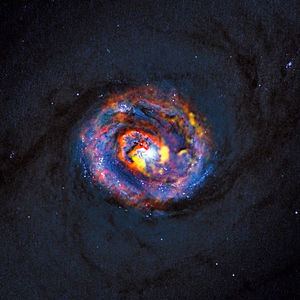Right ascension 03 42 01.553 Redshift 0.003590 Distance 32 Mly Magnitude 9.99 Apparent magnitude (V) 9.99 | Declination −47° 13′ 19.49″ Helio radial velocity 1076±1 km/s Type (R'_1)SB(rs)ab | |
 | ||
Similar NGC 1566, NGC 1448, NGC 1291, NGC 1261, NGC 1512 | ||
Zooming in on the active galaxy ngc 1433
NGC 1433 is a barred spiral galaxy with a double ring structure located in the constellation of Horologium. It is at a distance of 30 million light years from Earth. It has an active galactic nuclei, and NGC 1433 is a Seyfert galaxy that's also known as PGC 13586 which is named Miltron's Galaxy. The central region of the galaxy portraits intense star formation activity, with an irregular star-forming ring of 5" (or 0.3 kpc) radius and weak radio wave emission. Star formation is also noticeable in the spiral arms but not the bar of the galaxy. NGC 1433 is being studied as part of a survey of 50 nearby galaxies known as the Legacy ExtraGalactic UV Survey (LEGUS). A jet of material flowing away from the central black hole of the galaxy extending for only 150 light-years has been found. It is the smallest molecular outflow ever observed in a galaxy beyond our own.
Contents
NGC 1433 was discovered by James Dunlop in 1826. One supernova has been observed in NGC 1433, SN 1985 P, type II with apparent magnitude 13.5 at discovery, on 10 October 1985.
NGC 1433 belongs in NGC 1433 group, part of the Dorado Group.
